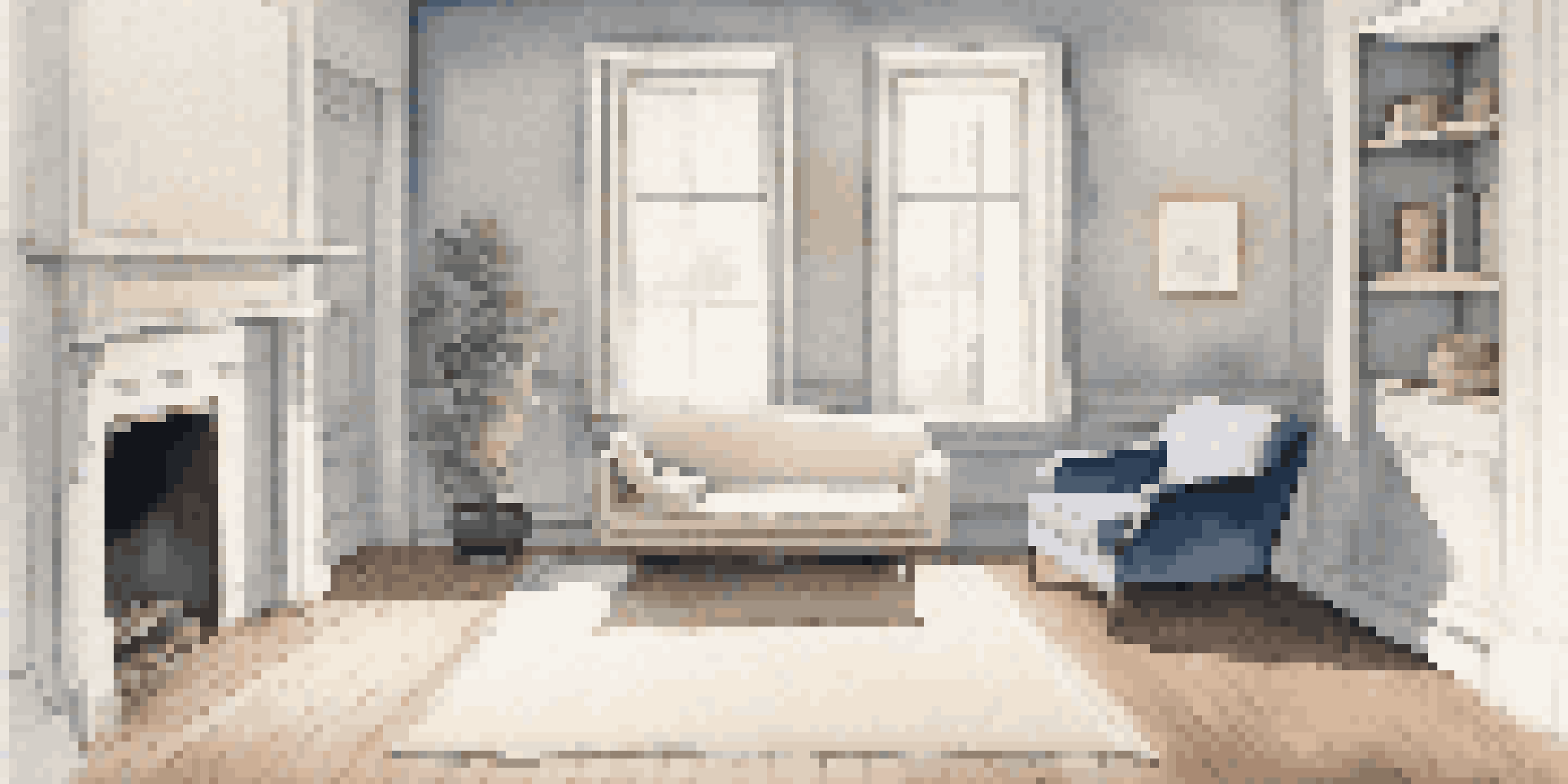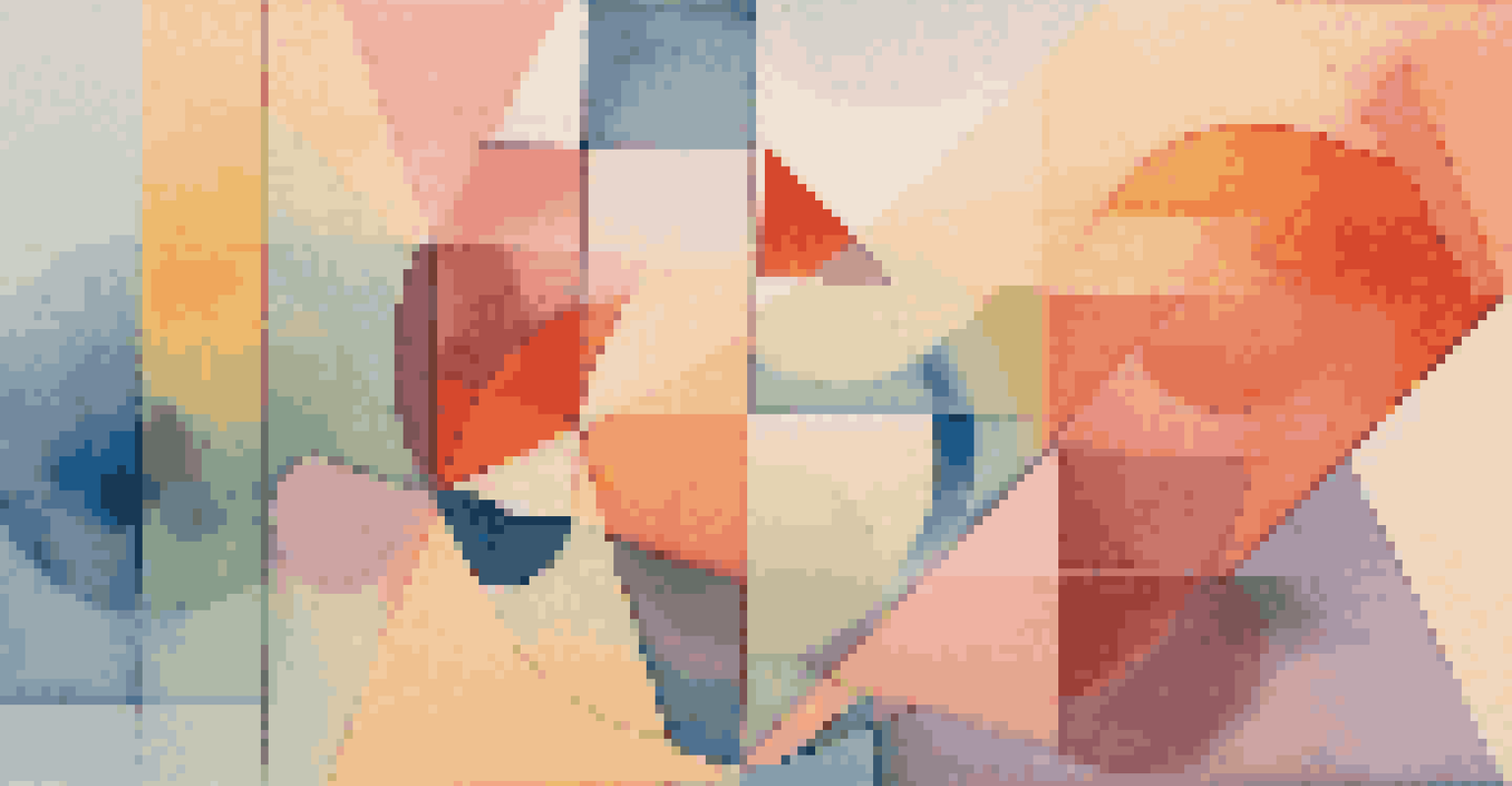Minimalism and Abstraction: Finding Meaning in Form

Understanding Minimalism: Less is More
Minimalism is a design philosophy that emphasizes simplicity by stripping away the unnecessary. This approach allows the essence of an object or idea to shine through, much like a sculpture revealed from a block of marble. Instead of overwhelming the viewer with details, minimalism invites them to focus on what truly matters.
Simplicity is the ultimate sophistication.
For example, think of a serene, uncluttered room with just a few carefully chosen pieces of furniture. Each item serves a purpose and adds value, creating a space that feels peaceful and intentional. This clarity in design helps foster a sense of calm and allows for deeper connections with the objects present.
Ultimately, minimalism encourages us to reflect on our relationships with our surroundings. By removing distractions, we can appreciate the beauty in simplicity and find meaning in the forms that remain.
Abstraction: The Essence of Representation
Abstraction in art and design involves distilling forms down to their fundamental qualities, often stripping away real-world references. This process can evoke emotions and ideas without relying on literal interpretations. For instance, a simple geometric shape can convey a sense of stability or movement, depending on its context.

Artists like Wassily Kandinsky and Piet Mondrian explored abstraction to express their inner thoughts and feelings. Their works invite viewers to engage with the art on a personal level, interpreting meaning based on their own experiences. This openness is what makes abstraction so powerful—it transcends the literal and allows for personal connections.
In a world filled with noise and chaos, abstraction offers a refuge. It encourages us to look beyond the surface and discover deeper meanings that resonate with our own lives.
The Intersection of Minimalism and Abstraction
When minimalism and abstraction come together, they create a unique language of design that speaks volumes through simplicity. This intersection allows artists and designers to convey complex ideas with minimal elements, making their work accessible and engaging. Think of a simple line drawing that captures the essence of a person or an object—it's both minimalist and abstract.
Art is not what you see, but what you make others see.
In modern architecture, we see this blend in structures that utilize clean lines and open spaces, allowing natural light to flow in. These designs not only look aesthetically pleasing but also create a harmonious environment. Such spaces invite us to experience our surroundings in new ways, stripping away distractions and focusing on form and function.
This synergy between minimalism and abstraction encourages creativity and innovation. By embracing both philosophies, we can foster environments that inspire thought and connection.
The Role of Color in Minimalism and Abstraction
Color plays a crucial role in both minimalism and abstraction, influencing how we perceive and interact with a piece. In minimalist designs, a limited color palette can evoke feelings of tranquility and focus, drawing attention to the form itself. For example, a single bold color against a neutral backdrop can create a striking visual statement.
In abstract art, color can convey emotions or narratives without the need for recognizable subjects. Artists often use color theory to evoke specific feelings—warm colors might instill energy, while cool tones can promote calmness. This emotional resonance allows viewers to connect with the artwork on a personal level, deepening their engagement.
Ultimately, the interplay of color within minimalism and abstraction enhances the overall experience, guiding our emotions and thoughts as we engage with the design.
Finding Meaning in Minimalist Forms
While minimalism emphasizes simplicity, it also challenges us to find meaning in what is absent. The space around an object can be just as significant as the object itself. For instance, a lone chair in an empty room can prompt reflection on solitude or contemplation, transforming the ordinary into the profound.
This process of finding meaning encourages mindfulness. By focusing on fewer elements, we can appreciate the subtleties and nuances that might otherwise go unnoticed. It invites us to slow down and engage with our surroundings in a more meaningful way.
In this sense, minimalism is not just about aesthetics; it's a philosophy that encourages deeper understanding and connection with the world around us.
Abstraction as a Catalyst for Imagination
Abstraction encourages us to tap into our imagination, allowing for a wide range of interpretations. When faced with abstract forms, our minds fill in the gaps, creating personalized narratives that enhance our understanding of the piece. This imaginative engagement can lead to new insights and perspectives, making art and design a collaborative experience between creator and viewer.
For example, an abstract painting may evoke a memory or emotion unique to each viewer, transforming a simple visual into a deeply personal experience. This connection fosters a dialogue, inviting us to share our interpretations and experiences with others.
In this way, abstraction not only broadens our appreciation for art but also enriches our understanding of ourselves and our place in the world.
Embracing Minimalism and Abstraction in Daily Life
Incorporating minimalism and abstraction into our daily lives can lead to greater clarity and fulfillment. By simplifying our environments and focusing on essential elements, we can reduce stress and enhance our well-being. This might mean decluttering our living spaces or choosing to engage with art that resonates with us on a deeper level.
Additionally, embracing these philosophies in our routines can encourage mindfulness. By being intentional about our choices, we can cultivate a greater appreciation for the present moment, finding beauty in the simplicity of everyday tasks.

Ultimately, minimalism and abstraction offer us tools to navigate a complex world. By embracing these concepts, we can create more meaningful lives, enriched by the beauty of form and the depth of thought.